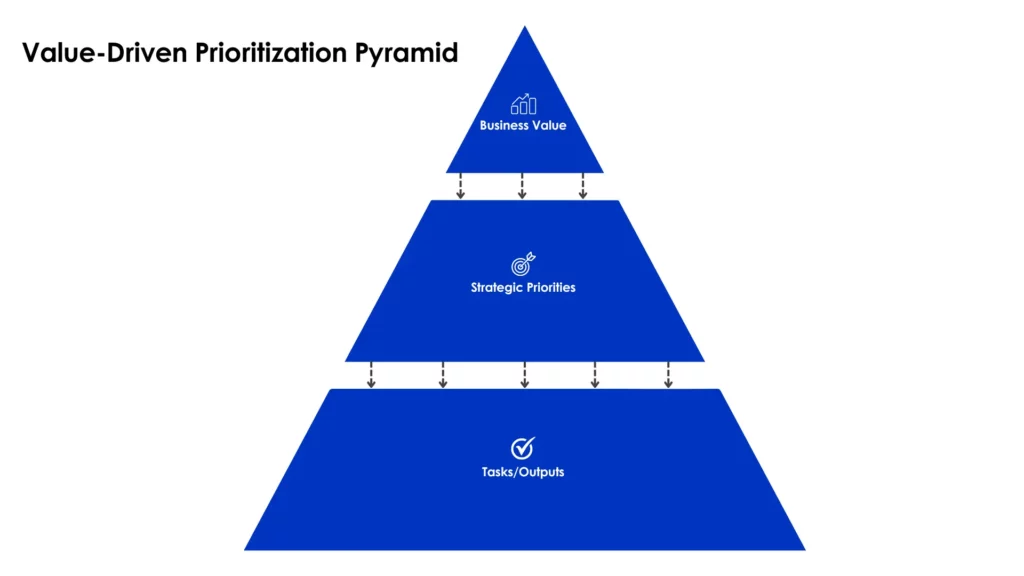Introduction
After the initial rush of Agile adoption, many organizations face the challenge of sustaining momentum. Over time, it’s easy for teams to slip back into old ways of working—reverting to traditional practices that stall progress, slow value delivery, and dilute the benefits of Agile. Teams that were once energized by the promise of faster delivery and greater flexibility often begin to lose momentum over time. For leaders responsible for overseeing Agile at scale, it becomes clear that sustaining long-term success requires more than just maintaining velocity—it demands strategic enterprise-level agile planning.
What is enterprise agile planning?
Enterprise agile planning refers to the strategic approach of applying Agile methodologies across an entire organization, scaling Agile principles beyond individual teams to manage complex portfolios and align work with overarching business goals. It involves coordinated planning, cross-team collaboration, and real-time visibility into progress, enabling organizations to remain adaptable while ensuring that Agile initiatives contribute to long-term strategic objectives
To sustain Agile practices and overcome fatigue, organizations must adopt key behaviors that foster continuous alignment with business goals, cross-team collaboration, and a relentless focus on delivering value. In this article, we’ll explore five critical five critical checkpoints that serve as guardrails for keeping Agile initiatives on track.
These checkpoints serve as essential touchstones for ensuring your Agile initiatives not only stay on course but also evolve with the needs of your organization. Whether you’re leading a transformation as a CIO, COO, or head of PMO, these insights will provide practical strategies for driving meaningful results and maintaining your organization’s agile maturity.
Checkpoint 1: Guarding Against Agile Complacency
As Agile practices become embedded in an organization, there’s a natural tendency for teams to drift back into familiar patterns. Over time, the urgency that fueled early Agile successes can give way to routine, making it easy to fall back into traditional or waterfall processes. This gradual shift can reduce the impact of Agile and weaken its ability to drive meaningful change at scale.
Leaders need to remain vigilant to prevent this kind of complacency from taking root. Agile isn’t about simply following processes—it’s about fostering continuous improvement, collaboration, and adaptability. Keeping those principles alive requires intentional effort, especially as organizations grow and scale.
How to keep teams engaged and agile
- Reinforce Agile principles through reflection: Rather than allowing retrospectives to become a formality, encourage teams to see them as an opportunity for genuine reflection. By regularly reviewing not only what went wrong but also what can be improved moving forward, teams can stay committed to growth and evolution. This isn’t about micromanagement but about fostering an environment where self-improvement is a core value.
- Encourage learning and experimentation: Innovation thrives when teams are given the space to experiment with new ideas and processes. Create an environment where teams feel supported to try out different approaches, even if it means some initiatives won’t work out as planned. This freedom can prevent stagnation and helps teams stay dynamic and engaged.
- Nurture a culture of continuous adaptation: Agile is built on the idea of being responsive to change. Leaders can model this behavior by remaining open to adjustments in strategy or execution as new data and insights emerge. By emphasizing adaptability as a positive trait rather than a sign of instability, teams will feel empowered to pivot when needed without feeling pressured to adhere rigidly to plans.
- Facilitate conversations around value delivery: Instead of focusing solely on adherence to Agile practices, shift conversations towards outcomes and value creation. This approach encourages teams to think critically about how their work contributes to the larger organizational goals, making it easier to stay motivated and aligned with business objectives.
Checkpoint 2: Ensuring continuous alignment with business strategy
A significant challenge in scaling Agile across an organization is maintaining a clear connection between initiatives and overarching business goals. As teams become more autonomous and focused on their immediate deliverables, there’s a risk that their work may drift away from the broader strategic objectives. Without regular alignment, even the most efficient Agile teams can deliver outputs that don’t directly contribute to the company’s strategic vision.
Maintaining alignment requires a proactive approach from leadership, ensuring that Agile teams understand how their work fits into the big picture. This isn’t about imposing top-down control; rather, it’s about creating a feedback loop between strategy and execution, so that teams can adjust their efforts in real-time to stay on track.
How to keep Agile initiatives aligned with strategic goals
- Make business strategy visible and accessible: To stay aligned, teams need to have a clear understanding of the company’s strategic priorities. Leaders can facilitate this by ensuring that the organization’s goals are transparent and readily available. This could mean regularly sharing updates on business objectives or integrating strategic priorities into PI planning sessions. When teams have a direct line of sight into the company’s long-term goals, it becomes easier for them to make informed decisions about their work.
- Promote two-way communication between teams and leadership: Alignment is not just about teams following top-down directives—it’s also about ensuring that leadership has visibility into what’s happening at the ground level. Regular communication between teams and executives can help surface insights or challenges that might require adjustments to the overall strategy. Leaders should foster an environment where teams feel comfortable providing feedback about how their work is impacting, or being impacted by, strategic shifts.
- Regularly reassess and adjust priorities: Business goals are rarely static. To ensure continuous alignment, Agile initiatives need to be regularly reassessed against changing market conditions and business priorities. Leaders can guide teams in this process by setting up frequent checkpoints, such as quarterly reviews or strategic planning sessions, where priorities are revisited and adjusted based on new information.
- Encourage a strategic mindset at all levels: Rather than expecting alignment to happen only through direct instruction, cultivate a mindset where everyone in the organization, from leadership to delivery teams, thinks strategically about their work. Leaders can do this by empowering teams to make decisions that reflect both short-term tactical goals and long-term strategic objectives. When teams are encouraged to think about the "why" behind their work, they’re more likely to stay aligned with business goals organically.
By fostering transparency, communication, and flexibility, leaders can ensure that Agile initiatives stay tightly aligned with the business strategy. This alignment is essential for delivering meaningful outcomes at scale and for making sure that Agile doesn’t just result in faster delivery—but in smarter, more strategically valuable work.
Checkpoint 3: Facilitating cross-team synchronization
As organizations scale Agile across multiple teams, one of the most significant challenges is ensuring effective synchronization across departments. While individual teams may operate efficiently within their own context, the lack of communication and collaboration between teams can lead to duplicated efforts, misaligned priorities, or delays due to dependencies that aren’t properly managed. This fragmentation not only undermines Agile’s potential but also slows down the entire organization’s ability to deliver value at scale.
Cross-team synchronization is essential to ensure that teams don’t operate in silos but instead work in harmony towards shared objectives. Achieving this level of coordination requires more than just tools and processes—it requires a culture of transparency and shared ownership of outcomes.
How to foster synchronization across Agile teams
- Create visibility across teams and portfolios: One of the simplest ways to encourage synchronization is to provide a clear, shared view of what other teams are working on. Tools like Kanban boards, roadmaps, or centralized dashboards can help teams see each other's progress, dependencies, and priorities. When teams are aware of how their work fits into the larger organizational context, they can coordinate efforts more effectively and avoid duplication or conflicting priorities.
- Encourage regular cross-team communication: Formal communication channels, such as regular cross-team sync meetings or coordination stand-ups, can be extremely valuable for keeping teams aligned. However, informal communication should also be encouraged. Leaders can foster a culture where teams feel comfortable reaching out to one another to resolve dependencies or collaborate on shared goals without waiting for formal meetings.
- Manage dependencies proactively: As teams scale, managing dependencies between them becomes increasingly important. Leaders can help by encouraging teams to identify dependencies early and plan around them. This might include regularly updating dependency maps, anticipating bottlenecks, and ensuring that teams have the autonomy to resolve issues directly. Managing dependencies proactively reduces friction and helps avoid the delays that can arise when teams are overly dependent on one another.
- Promote shared ownership of outcomes: Synchronization improves when teams feel they are working towards a common goal rather than their own isolated objectives. Leaders should emphasize the idea that success is measured not just by individual team performance but by the collective delivery of value. This might involve cross-team OKRs (Objectives and Key Results) or joint retrospectives that encourage teams to reflect on how they collaborate and contribute to shared outcomes.
By fostering synchronization across Agile teams, leaders can help eliminate silos, reduce inefficiencies, and ensure that the organization functions as a cohesive unit. The result is a more fluid, responsive Agile environment where teams collaborate seamlessly to deliver on shared objectives and drive value across the entire portfolio.
Checkpoint 4: Prioritizing value over output
In the race to deliver faster, many organizations fall into the trap of measuring success based on output—how much work is being completed—rather than focusing on the real impact of that work. Agile was never just about increasing delivery speed; it was always about delivering value. However, as Agile scales, it becomes easy for teams to prioritize completing tasks and hitting deadlines over ensuring that their work drives meaningful business outcomes.
Shifting the focus from output to value requires a mindset change at all levels of the organization. Leaders play a key role in driving this shift by encouraging teams to constantly assess how their work contributes to the bigger picture and aligns with the organization's strategic goals. Prioritizing value ensures that Agile efforts aren’t just producing more but producing what matters most.

How to maintain a value-driven approach in Agile teams
- Set value-based prioritization criteria: It’s crucial to establish a clear, shared understanding of what “value” means for the organization. Leaders should work with teams to define criteria for prioritizing work based on the potential business impact, customer needs, or strategic alignment. This might involve scoring features or initiatives based on their expected contribution to business goals rather than simply prioritizing based on urgency or effort required.
- Measure success by outcomes, not outputs: Traditional metrics like velocity or the number of features delivered can, in some cases, create a false sense of progress. Instead, encourage teams to measure their success based on outcomes—whether their work is achieving the desired business impact. This could mean tracking customer satisfaction, revenue growth, or improved operational efficiency as key indicators of value delivered.
- Revisit priorities regularly: In a dynamic business environment, what constitutes value can change quickly. Leaders should encourage teams to regularly reassess their priorities and be open to pivoting when necessary. This ensures that resources are always being directed toward the highest-value activities, even as market conditions or business needs evolve.
- Focus on delivering incremental value: Rather than waiting to deliver value at the end of a long project or product cycle, teams should aim to provide incremental value at each stage. Leaders can help teams break down initiatives into smaller, value-driven increments, ensuring that even early-stage work contributes meaningfully to business goals. This also allows for faster feedback loops, where teams can adjust based on what delivers the most value in real time.
By shifting the focus from how much is being produced to how much value is being created, leaders ensure that Agile delivers real business outcomes rather than just faster outputs. This mindset encourages teams to think strategically about their work and keeps the organization focused on continuous improvement and meaningful impact.
Checkpoint 5: Reinforcing a culture of adaptability
One of the defining strengths of Agile is its inherent flexibility—the ability to pivot quickly in response to new information, market shifts, or evolving customer needs. However, as organizations scale Agile, maintaining this adaptability can become a challenge. The more complex and structured teams and processes become, the harder it can be to preserve the core Agile principle of responding to change over following a fixed plan.
At the enterprise level, maintaining a culture of adaptability requires deliberate effort. It’s not just about reacting to change but fostering an environment where change is embraced and seen as an opportunity for growth. This adaptability needs to permeate every level of the organization, from strategic decision-making to the day-to-day actions of Agile teams.
How to foster and sustain adaptability in Agile organizations
- Encourage flexibility in planning: Leaders should model flexible thinking by promoting plans that can evolve as circumstances change. Rather than locking teams into rigid roadmaps, provide high-level goals and allow room for teams to adjust their approach as they gather new information. This ensures that teams can stay responsive to both internal and external shifts while maintaining alignment with business objectives.
- Promote experimentation and learning: Adaptability thrives when teams feel empowered to try new things without fear of failure. Encourage a culture where experimentation is not only allowed but celebrated. When teams are given the freedom to test new ideas, they can discover innovative solutions that may not have emerged through rigid, predetermined paths. This keeps the organization nimble and able to respond to challenges with creativity.
- Implement short feedback loops: A key way to maintain adaptability is by shortening feedback loops. Whether through shorter sprints, regular retrospectives, or frequent customer check-ins, quick feedback helps teams adjust rapidly and stay aligned with evolving business needs. Leaders should support practices that provide real-time insights, allowing teams to make informed decisions and course-correct without delay.
- Encourage adaptability at the leadership level: Adaptability isn’t just for Agile teams—it starts at the top. Senior leaders should model flexible decision-making and be willing to adjust strategies when market conditions or organizational priorities shift. When leadership demonstrates a willingness to pivot and re-prioritize based on new data, it sets a powerful example for the rest of the organization.
By reinforcing a culture of adaptability, leaders help their teams stay responsive to change and continuously improve. This allows organizations to navigate uncertainty, seize new opportunities, and ensure that Agile remains a dynamic force for delivering value.
Conclusion
Sustaining Agile at scale requires more than just following processes—it’s about fostering the right behaviors and mindset across the entire organization. By guarding against complacency, ensuring continuous alignment with business strategy, facilitating cross-team synchronization, prioritizing value over output, and reinforcing a culture of adaptability, senior leaders can ensure that their Agile initiatives continue to deliver real value, even as they grow in complexity.
These five checkpoints serve as critical touchstones for any organization looking to maintain the momentum of their Agile transformation. By embedding these principles into your enterprise Agile planning, you can navigate the challenges of scale without losing sight of what makes Agile truly powerful—its ability to respond, adapt, and deliver meaningful outcomes.
Kiplot is designed to support organizations in driving accelerated value delivery, sustaining Agile practices across teams and portfolios, and ensuring that initiatives maintain alignment with strategic objectives. For organizations looking to drive their Agile transformation forward, explore how our Agile Portfolio Management Software can help you drive alignment, manage complex portfolios, and maintain agility at scale.

